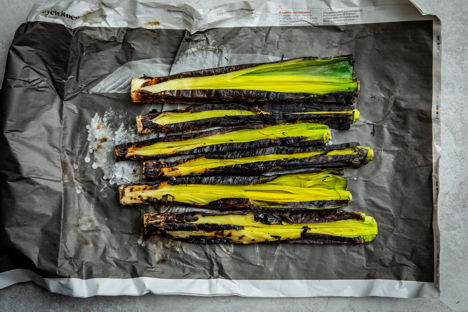Calçots are the onions at the centre of one of Catalonia’s messiest and most fun culinary traditions: the calçotada. Cultivated around the city of Valls in Tarragona, Catalonia, these vegetables are larger than spring onions but smaller than leeks, and are prized for their sweet flavour. PGI protected, they are known as ‘Calçot de Valls’ and are cooked outdoors over open fire, where they crackle and blacken on the grill, their fragrant smoke wafting under the noses of expectant diners.
How are calçots grown?
Calçots are cultivated in soil using a special method that encourages their sweet white stalks to grow to the desired length. Similar to ‘hilling’ potatoes, soil is pushed up around the calçot stalks as they grow - a method known as calçar in Catalan. While they’re in season from November through to April, it’s January and February when they’re at their best. Diners prepare accordingly by wrapping up warm!
How are calçots cooked?
Calçots are traditionally cooked over a live fire made from dried grapevine wood. They are cooked whole until their stalks are completely blackened, then wrapped in newspaper to finish cooking and steaming. This also keeps the calçots warm until they are ready to be eaten. Calçots are hard to find in the UK, but small leeks, which can be cooked in the same way, make a fantastic substitute. Served with a rich romesco sauce, they taste remarkably similar, becoming sweet and tender.
How to cook calçots (or small leeks) on the barbecue
Metric
Imperial
- 6 calçots, (or small leeks)
- romesco sauce, to serve
Light a barbecue for direct cooking over medium-high heat
Place the calçots or leeks directly over the fire and cook until completely blackened - around 20 minutes
- 6 calçots, (or small leeks)
Immediately wrap the calçots or leeks in newspaper and allow them to steam inside for at least 10 minutes before serving. If using leeks, it’s easier to split the leeks down the centre to serve, rather than attempting to push the charred layer from top to bottom, as one would with calçots. Serve with the romesco sauce
- romesco sauce, to serve
How are calçots eaten?
At a calçotada, you can expect to receive your calçots still wrapped in newspaper. This means it’s time to don your bib and get messy, unwrapping the onions and peeling away their charred exteriors to reveal bright green flesh within. This peeling is done, ideally, in one fell swoop, pushing the charred outer layer of the onion from top to bottom, revealing the tender edible parts inside. The root end of the calçot can then be dipped into sauce and dangled root first into your mouth. Getting messy is part of the fun of a calçotada, and is not optional!
What are calçots served with?
Calçots are served with salbitxada or romesco, both beautiful rust-red sauces made with nuts, charred peppers and olive oil. Once the onions have been consumed, it’s time to move onto grilled meats such as Butifarra sausages, lamb chops and beef, which are cooked in the brases (embers) of the fire.
There will also be copious amounts of red wine, served from a porrón, which resembles a jug with a long pointed spout. The diner holds the jug aloft and pours the wine into their own mouth, simultaneously moving it further away, creating a dramatic long stream of wine that only adds to the fun. A beginner may find this technique takes some getting used to, but it’s all part of the experience, and seeing a seasoned Catalan in action is something to behold.
Which flavours work with calçots?
There are some flavours that are essential to the calçot experience, such as smoke from the barbecue, sweet red peppers, creamy nuts, red wine and plenty of local olive oil. However, calçots are onions, which means they match with many of the same flavours as spring onions. Why not try serving them alongside a classic Spanish tortilla with some allioli, or plan your own calçotada-style celebration with grilled lamb chops and plenty of full bodied red wine.
Get in touch
Please sign in or register to send a comment to Great British Chefs.


